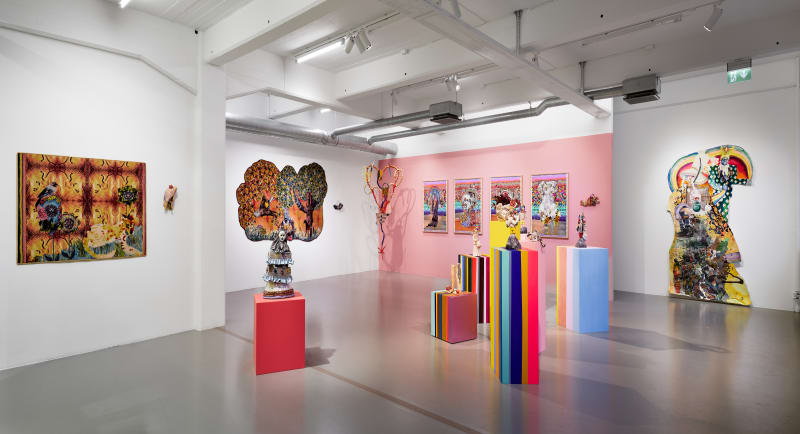After the success of Cosmonación at the 60th Venice Biennale in 2024 and the subsequent solo exhibition Cosmonación – Modersberget at Bonniers Konsthall, Chilean-Swedish artist Valeria Montti Colque (b. 1978) returns to the intimate realm of drawing – to the place where everything begins.
We are thrilled to present Valeria Montti Colque in her first solo exhibition with the gallery, curated by Yuvinka Medina.
After the success of Cosmonación at the 60th Venice Biennale in 2024 and the subsequent solo exhibition Cosmonación – Modersberget at Bonniers Konsthall, Chilean-Swedish artist Valeria Montti Colque (b. 1978) returns to the intimate realm of drawing – to the place where everything begins.
While her monumental works examined how cultural heritage can be interpreted and reshaped within the framework of an in-between identity, she now turns her gaze inward – toward the line, the hand, and the concentrated gesture through which the personal narrative takes form.
“Through the mountain, I wanted to create a place where my children can feel love for the earth – a sense of belonging, and the certainty that the ancestors are always near.”
— Valeria Montti Colque
The exhibition Jag bär berget, du bär mig (I Carry the Mountain, You Carry Me) marks Montti Colque’s first collaboration with Galleri Duerr and brings together drawings, collages, and sculptures from different moments in her more than twenty-year practice – many shown here for the first time. The works trace ideas that later evolved into large-scale installations and performances, revealing drawing as the foundation of her artistic language – the place where her worlds first take shape, and to which she continually returns.
For Montti Colque, drawing is a way of thinking – a process in which the line opens pathways to new stories, dreams, and memories. From this movement emerge collages, sculptures, and textile landscapes, where the image gains body and becomes matter. She works with graphite, thread, clay, paper, and found objects – materials marked by hands, bodies, and daily life, where touch itself becomes part of the story. By allowing her materials to speak, she creates a universe in constant transformation, where each work becomes both a continuation and a new beginning in an unfolding narrative.
The relationship between mother and child is one of Montti Colque’s most enduring themes – a motif that appears across materials, scales, and time. Through it, she explores the meeting of generations, bodies, and memories. These works embody the bonds that endure across distances: the language passed on against all odds, and the love that continues to move between worlds.
Montti Colque’s practice is deeply rooted in her experience as the daughter of Chilean exiles, born and raised in Sweden. Her childhood in Söderhöjden, Järfälla – a suburb shaped by diversity, cultural richness, and solidarity – formed a vibrant weave of languages, stories, and communities. At home, a constant longing for her parents’ homeland stirred an early awareness of distance, heritage, and belonging. Through family stories that reach back to the Andean Aymara culture, she has sought her own ways of understanding and expressing these themes – not as a return, but as a movement between places and times.
This dual grounding – between homeland and exile, heritage and the present – forms a vital current in her art. Here, the personal meets the collective, the local meets the mythical. The mountain, the rainbow, and the cloud appear as living beings – symbols of continuity, transformation, and belonging in motion.
Within this world of connections and returns, her figures emerge: Jokerita, the female trickster who moves against the grain, carrying both anger and humor; Mamita Montaña, the spiritual being who bridges the Andes and the Swedish mountains; and Helgondjuret (The Saintly Animal), a protective figure born from resistance, whose sharpness becomes armor and whose vulnerability turns into strength. These are self-portraits in constant transformation – mythical, ritual, and profoundly human. They move between worlds and bodies, between the earthly and the spiritual, showing how belonging can be both fluid and rooted – a movement rather than a fixed place.
Montti Colque’s aesthetic is one of abundance and intensity. Colors, patterns, glitter, and ornamentation form a visual language that stands in contrast to Western minimalism – an art that celebrates what has often been marginalized: the feminine, the popular, the diasporic. Her works carry traces of both play and ritual, of everyday life and spirituality.
To enter Valeria Montti Colque’s world is to encounter an artist who allows her images to live, breathe, and transform. Her universe moves in circles rather than straight lines – each return becoming a metamorphosis, a way of letting memory and experience find new form. In her art, we glimpse the force that endures across time and distance: the bonds between generations, the love that travels across divides, and the creative act that makes closeness possible, even from afar.
— Yuvinka Medina

